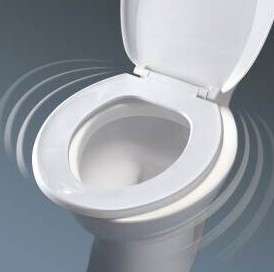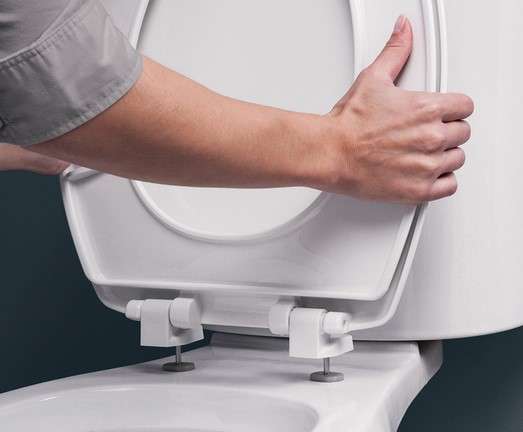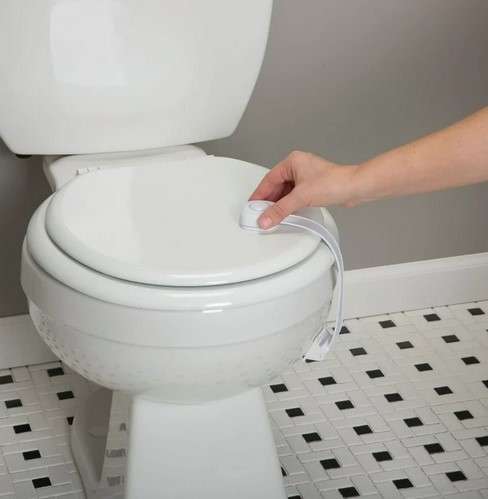Do you have a toilet seat that keeps moving? It can be a real pain, especially if you’re trying to use the toilet.
Not only is it annoying, but it can also be dangerous. If the seat is loose, it could fall and hit you or your child.
In this blog post, we’ll show you how to stop a toilet seat from moving. We’ll provide simple DIY tips that you can follow to fix the problem yourself.
So if you’re tired of dealing with a loose toilet seat, read on!
The problem Why toilet seat move when in use?
The movement of a toilet seat can be caused by a number of variables, and resolving the issue necessitates an awareness of the various causes.

Here are some of the most common reasons why a toilet seat may move:
- Loose Bolts: Loose bolts are one of the most prevalent causes of a shaky toilet seat. Due to constant use, the bolts that secure the seat to the bowl can become loose over time. This is readily corrected by tightening the bolts using a screwdriver or a wrench.
- Worn-out Hinges: Over time, the hinges connecting the seat to the bowl can wear out, causing instability. This problem can be resolved by inspecting the hinges for signs of wear and tear and replacing them as needed.
- Problems with Plastic Nuts: Some toilet seats feature plastic nuts that hold the bolts in place. If these nuts become damaged or worn, the seat may not be properly secured. Replacing broken nuts can aid with seat stability.
- Inadequate Installation: If the toilet seat was not properly fitted in the first place, it may not be firmly attached. This problem can be solved by double-checking the installation instructions and confirming that all components are properly aligned.
- Worn Bumpers: The bumpers on the seat’s bottom that make contact with the toilet bowl can wear out. If they are damaged or flattened, they can be replaced to increase stability.
- Material Degradation: The material of the toilet seat itself can degrade with time, particularly in lower-quality seats. If the seat is clearly fractured or deteriorated, replacing it may be the best option.
- Problems with the Tightening Mechanism: To prevent movement, certain toilet seats include specific tightening mechanisms. If this mechanism is broken or damaged, the seat may not be properly secured. The problem can be solved by inspecting and, if necessary, replacing the tightening mechanism.
Addressing the problem is dependent on determining the precise cause in each case.
Regular maintenance and inspections can help keep the toilet seat from becoming loose in the first place.
What are the dangers of a loose toilet seat?
A dangling toilet seat can cause a variety of hazards and difficulties, both in terms of safety and hygiene.
Here are some of the potential hazards of a loose toilet seat:
- Accidents and Slips and Falls: A shaky or loose toilet seat raises the chance of an accident, especially for people who have trouble keeping their balance, such as the elderly or those with mobility challenges. Falls or injuries might result from an abrupt movement or detachment of the seat.
- Hygiene Concerns: A loose toilet seat can create gaps and voids between the seat and the bowl, allowing bacteria and germs to thrive. This can jeopardize restroom hygiene and increase the possibility of contamination.
- Damage to the Toilet: A constantly changing seat might lead to toilet wear and tear. This movement may eventually harm the toilet’s hinges or other components, necessitating more extensive repairs or replacement.
- Disturbance in Noise: When in use, a loose toilet seat can make undesired noise, which can be disturbing, especially in shared living situations. This can have an effect on the overall comfort and ease of using the restroom.
- Ineffective Flushing: A loose toilet seat may interfere with the toilet’s correct operation, impacting the flushing mechanism. This could cause incomplete flushes or obstructions, resulting in plumbing problems and the need for repairs.
To address these risks, any unsecured toilet seat should be repaired as soon as possible. Typically, this entails adjusting or replacing the seat’s mounting hardware.
Regular maintenance and periodic examinations can help prevent these problems and guarantee that the toilet is used safely and efficiently.
How to Stop a Toilet Seat from Moving

If your toilet seat is always wobbling, here are some expert suggestions to help you stabilize it:
Check the Bolt Tightness: Most toilet seats are secured using bolts that go through the bowl and tighten underneath.
These bolts might become loose over time, causing the seat to wobble. Tighten them with a wrench, but be careful not to overtighten and damage the porcelain.
Use Lock Washers or Threadlocker: To prevent bolts from loosening over time, use lock washers or threadlocker (such as Loctite).
These materials might aid in the secure connection of the toilet seat to the bowl.
Metal bolts and nuts are more resistant to wear and fracture than plastic bolts and nuts. Consider using metal bolts and nuts for extra strength and stability.
Replace Damaged Hinges: If your toilet seat has hinges, inspect them for damage or wear. Consider replacing them with new, robust hinges if they are damaged.
Tighten the Hinge: Some toilet seats have adjustable hinges that allow you to manage the tightness. Adjust these hinges to guarantee a secure fit while avoiding damage.
Non-slip rubber bumpers put between the toilet bowl and the seat can help to reduce movement and provide additional stability.
Examine the Seat or Bowl for Damage: Examine the seat and bowl for cracks or damage. It may be difficult to establish a stable fit if either is compromised. Consider replacing the damaged component in such circumstances.
Consider a Toilet Seat Stabilizer: Some devices on the market are specifically designed to steady toilet seats. These stabilizers give support and can help avoid movement.
Follow the manufacturer's recommendations: Always follow the directions that came with your unique toilet seat model. They may provide precise installation and maintenance requirements to prevent movement.How to Tighten a Toilet Seat
Here’s a step-by-step guide for tightening a toilet seat like a pro:
Gather the Required Tools: Make sure you have the proper tools for the job. The majority of toilet seats are held together using bolts and nuts.
A screwdriver (flathead or Phillips), an adjustable wrench, and maybe pliers are usually required.
Determine the Type of Toilet Seat: Different types of toilet seats have different tightening methods.
The two primary varieties are those with bolts and nuts and those with hand-tightenable plastic nuts.
Examine the Toilet Seat for Access Points: Look for access points or covers on the underside of the toilet seat. Some seats have covers that can be removed to reveal the bolts beneath.
Hold the Nut in Place: If your toilet seat contains bolts and nuts, locate the nuts by opening the access points.
Hold the nut in place beneath the toilet bowl with one hand. This keeps the nut from rotating when you tighten the bolt.
Tighten the Bolts: Using the screwdriver or wrench, tighten the bolts on the upper side of the toilet seat while holding the nut securely. To guarantee a secure fit, turn them clockwise. Excessive tightening can cause harm to the toilet or seat.
Check for Stability: After tightening, gently shake the toilet seat to ensure stability. You've effectively tightened it if it feels secure. If not, repeat the process or try replacing the broken bolts.
Hand-Tightening Nuts: If your toilet seat contains hand-tightening plastic nuts, simply twist them clockwise until snug. If you can't tighten them enough by hand, give them an extra turn with pliers.
Regular Maintenance: Check the tightness of your toilet seat on a regular basis to avoid it from getting loose over time. This is especially significant in high-usage homes.You can keep your toilet seat properly fixed by following these procedures. If you run into any problems or the seat becomes damaged, it may be time to consider replacing it.
How to Use a Toilet Seat Lock

Using a toilet seat lock is a simple procedure that assures the safety of children or anyone who may fall into the toilet.
Here’s a step-by-step tutorial to using a toilet seat lock correctly:
- Select the Correct Lock: Select a toilet seat lock that is compatible with your toilet model. There are many different types of locks on the market, such as adhesive strap locks and locking lids. Check if the lock is compatible with the design of your toilet.
- Clean and Dry the Surface: Ensure that the toilet seat and surrounding area are clean and dry before using any adhesive or installing the lock. This promotes good adhesion and keeps the lock from slipping.
- Position the Lock: If you’re using an adhesive strap lock, place it over the top of the toilet seat, securely attaching both sides. Follow the manufacturer’s directions for your particular lock.
- Adjust the Tightness: – Some locks may feature adjustable straps or mechanisms for tightening. Adjust the lock to your liking, making sure it is firm enough to prevent accidental opening but not so tight that it is impossible to use.
- Locking Lids: If you’re using a locking lid, make sure you follow the manufacturer’s directions. Typically, this entails securing the lock to the back of the toilet seat or bowl.
- Verify the Lock: After installation, verify the lock to check it is working properly. Open the toilet seat to ensure that the lock is effectively keeping it from moving. If changes are required, make them as needed.
- Educate Family Members: – Ensure that everyone in the household is aware of and understands how to operate the toilet seat lock. This is especially crucial if you have youngsters, since they may be unfamiliar with the concept of a secured toilet seat.
- Regular Maintenance: Check the lock on a regular basis to verify it is securely in place. Adhesive straps may need to be replaced over time, so keep an eye out for any signs of wear and tear.
By following these procedures, you may properly use a toilet seat lock to improve home safety.
Always follow the manufacturer’s exact instructions for the lock you’ve chosen, since different models may have unique features or installation requirements.
How to Fix a Loose Toilet Seat
Repairing a sagging toilet seat is a typical household task that may be completed in a few simple steps.
As a toilet seat and toilet specialist, here’s a full tutorial on how to repair a loose toilet seat:
Materials Required:
- pliers or an adjustable wrench
- Screwdriver
- Nuts and bolts (replacement if necessary)
Step-by-Step Instructions:
Determine the Type of Toilet Seat: Toilet seats are classified into two types: those with bolts that can be tightened from the top and those with bolts that can only be tightened from the bottom. Determine the type you have.
Check for Visible Screws: If your toilet seat has visible screws on the top, tighten them with a screwdriver. Screw the screws in clockwise until they are tight. Overtightening may cause harm to the seat or the toilet.
Bottom-Mounted Bolts: If the bolts are underneath and you can't reach them from the top, flip open the covers on the seat hinges. Some covers snap off, while others may require a screwdriver.
Tighten Bottom-Mounted Bolts: Tighten the nuts on the bolts beneath the toilet bowl with an adjustable wrench or pliers. Tighten the nuts by turning them clockwise. Avoid overtightening once more.
Inspect the Hinges: Examine the hinges for damage or wear. Consider replacing the hinges if they are broken or cracked. Replacement hinge kits for toilet seats are available at most hardware stores.
Bolts and nuts (if necessary): Replace any worn or damaged bolts and nuts with new ones. A toilet seat bolt and nut set can be purchased at a hardware store. Remove the old bolts and nuts and replace them according to the package directions.
Apply Thread Locker (Optional): To keep the nuts from loosening over time, apply a little amount of thread locker to the bolt threads before tightening. This is optional, however it can increase stability.
Reassemble and test: After tightening the screws or bolts, reassemble any removed covers or caps. Check that the toilet seat is securely in place.You can effectively fix a loose toilet seat and ensure a sturdy and comfortable bathroom experience by following these professional methods.
Conclusion
To fix a shifting toilet seat, take a careful approach for stability and comfort.
Start by checking the hinges and bolts. Make sure they are tight. If needed, repair or replace them using the right tools. Choose high-quality hardware for better durability.
Think about upgrading to a slow-closing or soft-close toilet seat. This option reduces sudden movements and adds elegance to your bathroom. Check that it fits your toilet bowl and follow the installation instructions.
Regular maintenance helps prevent loosening over time. Periodically check the seat’s mounting hardware and tighten it if necessary. Teach family members the right way to use the toilet seat to avoid stressing the hinges.
By ensuring proper installation, using quality hardware, and maintaining the seat often, you can eliminate the annoyance of a moving toilet seat.
This creates a stable and comfortable bathroom experience for everyone.
Recommended Posts:-
Your Ultimate Resource on Polypropylene Toilet Seats: All You Need to Know!
Unveiling the Ultimate Toilet Seat Material: The Unrivaled Guide to Durability!
Are there any specific tools or materials I need to stop my toilet seat from moving?
It is critical to have a stable and secure toilet seat for a comfortable and hassle-free restroom experience. There are a few innovative methods and materials you can use to keep your toilet seat from unnecessarily shifting or wobbling.
First, purchase anti-slip toilet seat bumpers. These unobtrusive adhesive pads adhere easily to the underside of the seat and prevent excessive movement. They provide cushioning, reducing vibrations and guaranteeing a secure fit.
Consider using toilet seat stabilizers or tightening kits as well. These kits usually come with stabilizing bolts and nuts that may be simply placed to keep the toilet seat in place. Simply tighten the bolts to eliminate any undesired movement, resulting in a long-lasting and sturdy solution.
Rubber washers might work well for individuals who seek a temporary remedy. Rubber washers placed between the toilet bowl and the seat can provide more grip and prevent slipping. For maximum efficiency, choose ones that are resistant to water and wear.
Finally, anti-slip bumpers, stabilizing kits, and rubber washers can be used to hold your toilet seat securely in place. These solutions are not only functional, but also simple to install, assuring a long-term stable and comfortable bathroom experience.
Can I fix a loose toilet seat myself, or should I call a professional plumber?
Fixing a loose toilet seat can be a do-it-yourself project for many homes, providing a cost-effective alternative to calling a professional plumber. Before beginning the repair process, it is critical to determine the source of the looseness.
Check for any loose bolts or screws that hold the toilet seat to the toilet bowl. If that’s the case, tightening them with a screwdriver or wrench may suffice.
Begin by locating the securing bolts at the back of the toilet bowl beneath the seat. Lift the seat gently to reveal the bolts and look for any damage or wear. Tighten the bolts until snug if they are simply loose. If the bolts are damaged or stripped, replacement bolts are available at most hardware stores.
When the seat is held in place using plastic nuts, these can occasionally be tightened by hand. Consider replacing the nuts if they are damaged or won’t tighten. Make sure not to overtighten, since this can crack the toilet seat or damage the bowl.
If, after attempting these methods, the seat remains loose or there are indicators of more serious problems, it may be time to call a plumber. They can evaluate the situation, uncover any underlying issues, and propose a long-term solution.
A loose toilet seat is usually a simple fix, making it a good DIY job for individuals who are familiar with basic household maintenance.
Are there any preventive measures I can take to stop my toilet seat from becoming loose in the future?
It is critical to keep your toilet seat stable for both comfort and functionality. Consider following a few preventive actions to keep your toilet seat from becoming loose in the future.
To begin, make sure the bolts that hold the seat to the bowl are tightened on a regular basis. Vibrations and usage might cause these bolts to loosen over time. Check the tightness with a wrench on a regular basis and make changes as needed.
Invest in high-quality toilet seat hardware as well. Choose strong materials and hinges that can sustain repeated use. Cheap or substandard hardware can soon deteriorate, resulting in a shaky seat.
During installation, consider using a thread locker on the bolts. This adhesive holds the bolts in place, preventing them from loosening over time.
If your toilet seat includes plastic bolts, avoid overtightening them as this might cause cracking. Follow the manufacturer’s installation and maintenance instructions.
Finally, avoid slamming the toilet seat, which can cause wear and tear on the hinges and bolts. Lower the seat gently to avoid putting additional strain on the hardware.
You may enjoy a stable and secure toilet seat for the long term if you incorporate these preventive steps into your toilet seat maintenance regimen.